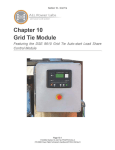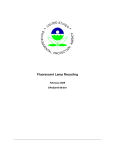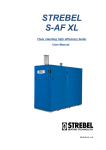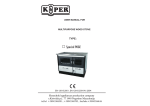Download Power Pallet Operation Manual - GEK Wiki
Transcript
ALL POWER LABS
GASIFIER EXPERIMENTERS KIT
Power Pallet
Operation Manual
Rev: 2.2; Updated 070210
Page 1
ALL POWER LABS
GASIFIER EXPERIMENTERS KIT
Table of Contents
ALL POWER LABS
GASIFIER EXPERIMENTERS KIT
I) Safety
II) Running the Power Pallet
1. GEK Preparation
2. Start the GEK
3. Testing
4. Wiring
5. Run the Engine
6. Create Power
IV) Shutting Down the System
V) Communicating with the GCU
VI) Maintenance
1. Gasifier
2. Engine
I) Safety
The purpose of gasification is to intentionally create H2 (~20%) and CO (~20%) which are the two main gaseous fuels that drives the chemistry of this technology. This chemistry works by reaching the combustion temperatures of wood around ~1200C. To minimize any risks, we have engineered the GEK to create producer gas
in a negative pressure, closed, on-demand system.
Before running a gasifier, please remember the following . . .
-Review the health guidelines of carbon monoxide: http://www.osha.gov/SLTC/healthguidelines/carbonmonoxide/
A gasifier can be a dangerous thermo-chemical device. Like most useful tools, it will do damage if used incorrectly. A gasifier purposely generates carbon monoxide and other dangerous volatile organic gases as an
interim step before combustion of the gas in a flare or engine. Carbon monoxide is colorless, odorless, and will
quickly colonize your hemoglobin, leaving no sites left for oxygen to naturally attach. Acute exposure to carbon monoxide can be harmful or fatal. Exposure to other VOCs is similarly problematic. (In short, it is somewhat like smoking cigarettes, just exponentially worse.)
Always use a gasifier outdoors, and with extensive ventilation. Always stay out of the smoke and/or produced
gas before it is combusted. This is NOT typical campfire smoke, even though it may smell similar. The carbon
monoxide concentrations in gasifier gas are higher than in other “smokes”. If you do not stay out of the smoke,
you can get in trouble quickly, usually before you realize it, please be aware.
Always have a carbon monoxide meter in the area where you are working. Ideally, hang one on a tether around
your neck. Carbon monoxide meters are included with the GEK Gasifier Kit and are also available at hardware
stores in the smoke detector section.
STAY OUT OF GASIFIER GAS AT ALL TIMES!!!
Page 2
ALL POWER LABS
GASIFIER EXPERIMENTERS KIT
II) Running the Power Pallet
1. GEK Preparation
a) Install Instrumentation
ALL POWER LABS
GASIFIER EXPERIMENTERS KIT
i) Thermocouples
Two thermocouples are included with the GEK. One for the top of the reduction bell and one for the bottom of
the reduction bell.
• Top of Reduction Bell: Install the longer 16th inch dia. thermocouple into the reduction bell. There is an
instrumentation port along the neck of the reactor that includes a 1/2 inch pipe nipple with a 1/2 cap. Thread
the thermocouple through the instrumentation port, then insert the tip of the thermocouple into the thermocouple protecting tube attached to the stainless steel reduction bell. Make sure the tip of the thermocouple is
touching the far end of the protecting tube so that it is inside the constriction of the hearth. Be sure to secure
and protect the thermocouple on the side of the reactor so that it is not in the way of the flow of biomass. Be
sure to seal up the port so that no air is able to enter.
• Bottom of reduction temperature: The cap on the
1/2’’ plumbing T of the manometer is the thermocouple port for the bottom of the reduction bell. A
thermocouple at this location will clear the bottom
of the reaction chamber inside the gas cowling.
Be careful when placing a thermocouple at this
location: If the thermocoule seems to jam, move it
around a little so that it will slide in between the gas
lines that are attached to the bottom of the reactor.
Place the thermocouple 1’’ from the inside the edge
of the reduction bell, any further can block the flow
of charcoal in this region.
Page 3
ALL POWER LABS
GASIFIER EXPERIMENTERS KIT
ii) Manometer
Fill up the manometer with water up to the zero mark. Colored fluid may be added to the manometer so that it
is more visible as long as the resulting fluid is the same density of water. Make sure there are no bubbles in the
manometer tube. If this occurs, disconnect the end of the tubing from the reactor and/or filter port temporarily
so that the bubbles can escape.
ALL POWER LABS
GASIFIER EXPERIMENTERS KIT
b) Insulation
Fill the space between the inner wall of the reactor and the stainless steel insert with insulating material. Charcoal dust, ash, perlite, pumice, or kaowool, for example, will work as insulation material in this area. There may
be other materials appropriate to your area that will suffice as an insulating layer. The material should be able to
handle a high heat environment.
Optional: The space between the hourglass reduction bell and the reactor around the nozzles can be filled with
insulation material also. Make sure the level of insulation material in this region is about 2 inches from the top
of the hourglass reduction bell. Warning: Make sure no insulation material is allowed inside the reduction bell.
Use a rag to plug the reduction bell so that no insulation material accidently falls into the bottom of the reactor.
Page 4
ALL POWER LABS
GASIFIER EXPERIMENTERS KIT
c) Fill Reactor with Charcoal
ALL POWER LABS
GASIFIER EXPERIMENTERS KIT
Fill the bottom of the reactor, as well as inside the
reUsing charcoal between .5” - 2” in diameter, fill the
reactor up to 1’’ - 2’’ above the ignition port/air nozzles.
Allow charcoal through the reduction bell, then vigorously agitate the ash grate. Repeat until the charcoal
has been allowed to completely fill the space between
the ash grate and the reduction bell. Do not use finer
particles or dust, as that will foul the reduction on start.
USE REAL WOOD CHARCOAL!
It is important to use real wood charcoal, not Kingsford or the like, which is mostly pressed coal dust. Charcoal
from a fireplace, fire pit, or mesquite BBQ charcoal will work. Make sure the charcoal is fully pyrolysed. To
the degree that imcompletely pyrolysed charcoal is used, tar will be produced on start up. To the degree wet
charcoal is used, steam will be produced on start up. Charcoal is hydroscopic so it is likely that it will be wetter
than you imagine, however this is OK, it will vaporize quickly. You will see this as white smoke at the beginning of the start.
d) Add Raw Biomass
Do not fill the rest of the reactor with charcoal. Layer the raw biomass on top of the charcoal. Fill the biomass
to the top of the reactor or hopper. Afix the lid on top of the reactor and make sure it is tight. Agitate the ash
grate and make sure all the fuel has settled. You may need to sift out larger chunks of biomass using a screen so
that bridging does not occur over the reduction bell; too many small particles or sawdust will tend to pack the
reactor limiting flow rate. Saw dust is better used as the filter material. (Before filling the top half of the reactor
with raw biomass see Step 2.b).
Page 5
ALL POWER LABS
GASIFIER EXPERIMENTERS KIT
b. Filter Media
ALL POWER LABS
GASIFIER EXPERIMENTERS KIT
Fill the filter housing with charcoal or saw dust. Use small particles smaller than 1/8th of an inch. This could
possibly be sourced from the sieving of the feedstock noted in the previous step. Fill the filter about two inches
from the top. On top of the filter media, place fabric (rags, or old t-shirts) or another air filtering material on top
to keep the finer particulates from entraining in the gas stream. (Warning: Use only cotton or natural fibers. Do
no use nylon or synthetic fibers. Some materials have the potential to melt and possibly be introduced into the
engine). Be sure to place the perforated filter plate on top of the air filtering material to hold it in place so that it
will not be sucked up into the gas exit port.
2. Start the GEK
Safety first! Be aware, and remember protective eye equipment, when dealing with the combustion of fuels
there is always a potential for explosion. With the GEK, there has never been any case of explosions more than
a small cough of flame that may protrude out of the ignition port while the combustion zone is stabilizing initially. Proceed forward with awareness and caution.
a) Air Flow
Connect the air compressor to the quick air connect of the ejector venturi. Remove the 1’’ air inlet cap on the
reactor and open the 1/4’’ air compressor valve. These are the only ports that should be open. The monometer
should respond easily upwards to 5 inH2O. Set the pressure drop across the reactor to about 3’’ H2O. If the
monometer does not respond, double check that all ports, valves, lids, and caps are closed excluding the valves
mentioned in this step. For further assistance, visit the Final Preparation Before Lighting webpage <http://
gekgasifier.pbworks.com/Final-preparation-before-lighting>. (You will need an air compressor capable of a
minimum of 4 cfm at 80psi. The air compressor is only used upon start up and shut down of the GEK).
Page 6
ALL POWER LABS
GASIFIER EXPERIMENTERS KIT
b) Ignition of the GEK
ALL POWER LABS
GASIFIER EXPERIMENTERS KIT
Be sure to start with dry biomass (no more than ~10% moisture content by dry weight). Between the charcoal/
raw biomass layer, pour in a 1/2 cup of diesel fuel (You may use other liquid fuels such as kerosine, biodiesel,
ethanol, methanol, gasoline, etc. WARNING: Liquid fuels with lower partial pressures will start to evaporate,
fumes could become explosive, this is why diesel and kerosene are recommended above the more volatile fuels
with quicker combustion rates. Make sure the container of fuel is well away from the GEK while lighting and
during operation! While we have done this with great success in the past, USE CAUTION and USE AT YOUR
OWN RISK).
It is easiest to light with a propane torch about an inch from the ignition port inlet so as to provide oxygen for
the propane. There are many other methods of lighting such as throwing a lit rag into the reactor on top of the
charcoal layer and establishing the combustion zone before adding raw biomass on top. Make sure that the air
is flowing into the reactor to be careful of potential back fire. Ignition has been shown to be possible with just
a propane torch, with lower flows leading to faster initial ignition. Recommended reactor pressure reading: 1”
H2O during ignition
c) Lighting the Reactor to Flaring the Gas
Watch the thermocouple readings from the bottom and top of the reduction bell. As the temperature increases
to 100C, any water in the system will turn into steam and escape through the burner. Anywhere in the range of
200-500 C (typically less than 1-3 minutes) the gas will be combustible, this will depend on the type of liquid
fuel you used to start. Keep a pilot flame (ex: a second propane torch) to help burn off the smoke on start up).
There is also a port on the 1/2’’ plumbing T on the ejector which is intended for a propane connection to ensure
a clean safe start up.
d) Controlling the Flare
After a few minutes you will be able to turn off the propane pilot flame for the flare. Adjust the oxygen mixture
on the flare to transition from a propane to woodgas flare (this is the 3/4” valve on the ejector venturi). Important: Keep the pilot light handy. In the case that flare extinguishes, it will need to be relit quickly. Remember,
do not breathe the gas when it is unburned. After it is burned, it is very clean.
Page 7
ALL POWER LABS
GASIFIER EXPERIMENTERS KIT
Notice: As the air pre-mix valve is closed, the flare will rise upward out of the burner as it requires more oxygen
for a complete combustion. In this case, there may not be enough oxygen to competely combust the gas allowing the hydrogen and carbon monoxide to be released. As the air pre-mix valve is opened, the flare will lower
into the burner. In this case, all of the wood gas is allowed to combust before exiting the burner. This ensures a
complete and clean combustion.
Notice: When the air pre-mix valve is opened, the suction from the ejector venturi is divided between the reactor and air pre-mix valve. This will lower the total vacuum across the reactor (and vice versa) as indicated on
the manometer reading. Make sure that the reactor is kept in range of the proper pull rate. The compressed air
valve may need to be opened/closed to control the flow across the ejector as the air pre-mix valve is adjusted to
keep the reactor pressure within range.
ALL POWER LABS
GASIFIER EXPERIMENTERS KIT
3. Testing
Conduct a few runs with just the GEK Gasifier before running the engine on wood gas. Due to the wide range
of variability in the both the characteristics and processing of biomass around the world, we suggest that you
run the GEK gasifier and test the gas, before introducing the gas to the engine. Consider the variables: percent
moisture, fixed carbon to volatile ratio, void space, bulk density, energy density, particle size, percent ash, etc.
Our Bear Kaufman has conducted some simple tests to compare the flow rates and temperature of the reactor vs.
tar production across various types of biomass. <http://gekgasifier.pbworks.com/Multi-fuel+Run+Comparison>
Refer to the temperature readings. It is recommended that the top of reduction temperature should be no lower
than 800C and the bottom of reduction temperature should be between 650-900C.
With wood chips (particle size: 1/4-1.5 inches, moisture content: <15% {dry weight}), we have found that 4’’
H2O is the about the minimum for extended running. The temperature readings on the GCU depicted below T00
thermocouple is typically the top of the reduction bell, and T01 refers to the bottom of the reduction thermocouple reading. The thermocouples for T02-T05, in the picture below, are located in various places for experimentation purposes.
Page 8
4. Wiring
ALL POWER LABS
GASIFIER EXPERIMENTERS KIT
ALL POWER LABS
GASIFIER EXPERIMENTERS KIT
a) Generator Head
We are currently using an ST Type synchronous AC generator. Consult the ST Generator Operation and Maintenance Manual: <http://www.utterpower.com/ST_manual.pdf>.
b) Battery
You will need to purchase a typical 12v DC car battery with lug type terminals. (For Kholer engine based
gensets, Kholer recommends using a car battery capable of 400 cold cranking amps (cca) minimum). Connect
the two lug connections to the battery. The red wire will be connected to the positive lead and the black wire to
the negative lead on the battery.
5. Run the Engine
a) Tension the Belt
Loosen the large clamping bolts on the engine.
Tighten the belt tensioning mechanism until the belt is
tensioned properly. Tighten the large engine clamping
bolts to secure the engine into place. (Make sure the
lagging side of the belt is not loose when the genset is
under load).
b) The Hand-off from Flare to Engine
This section assumes that testing has been performed to find the optimal temperature/vacuum range in which
the system will produce a clean producer gas given the biomass characteristics used for the run. If you introduce
tarry wood gas into your engine, it will damage your engine by sticking the intake valve(s) and piston rings. To
ensure this does not happen, use dry biomass, make sure that you are within the proper temperature and pressure
range in the reactor, double check seals on the gasifier, and make sure filters are not spent.
The Hand-off:
i) Make sure the flare is steady in the swirl burner. The flare should be down inside the swirl burner with the
flame terminating before reaching the top of the burner.
ii) If you have hooked up propane to the ejector venturi line, make sure that the valve and tank are OFF. The
wood gas flare should be sustained with out supplementing other fuels.
Page 9
ALL POWER LABS
GASIFIER EXPERIMENTERS KIT
ALL POWER LABS
GASIFIER EXPERIMENTERS KIT
• Manual Mixture Control
iii) Open the engine valve and close the ejector venturi gas valve.
iv) Crank the engine engine as soon as possible. Warning: When the gas valve to the ejector venturi is turned off
and before the engine has been turned on, the wood gas could potentially come out of the air pre-mix valve. Be
aware.
v) The engine will start when the air has been purged from the system and the correct air to wood gas ratio is
being offered to the engine. The air pre-mix valve will need to be near closed to deliver a richer mixture at first,
then slowly opened while cranking the engine. At some point in this slow opening you will cross the correct
mixture point and the engine will fire. As the engine starts to run, the air pre-mix valve may need to be adjusted
to provide the optimal air to fuel ratio. The air pre-mix valve position for the correct mixture will vary with
engine speed and load, as well as gas quality coming from the reactor.
vi) Close the compressed air valve to the ejector venturi.
• Automated Mixture Control
iii) Turn the Gasifier Control Unit (GCU) on and make sure the servo controlled air pre-mix valve is operational.
iv) At the same time, open the engine valve, close the air pre-mix valve, close the ejector venturi gas valve, and
close the compressed air valve to the ejector venturi.
v) Crank the engine. The engine may need to be cranked for a few seconds to purge the air from the system. Allow the starter to cool briefly if you need to crank for a longer period of time.
vi) Once gas reaches the engine, the oxygen sensor will detect the exhaust mixture and the readout on the oxygen sensor display should drop below 21.7 and the servo valve will adjust the valve to find the correct stoichiometric mixture and maintain constant operation. The automated mixture control will provide the optimal air to
fuel ratio with variability of engine engine speed and load, as well as gas quality coming from the reactor.
c) Set RPM/Voltage
Adjust the RPM of the engine until the
generator output is 60Hz (or 50Hz) and
120V (or 220V).
IV) Shutting Down the System
i) When shutting down the system, switch the wood gas back over to the burner.
ii) Close the engine valve while turning off the engine, open the gas valve to the ejector venturi, open the air
compressor valve, and adjust the air pre-mix valve while keeping the pilot light over the burner to ensure ignition of the flare.
iii) Over the course of about 5-10 minutes, slowly turn down the compressed air valve while adjusting the air
pre-mix valve to keep the flare lit at lower and lower flow rates.
iv) When the gas is no longer able to sustain a flare, close the gas valve to the ejector venturi, place the 1’’ cap
on the air inlet of the reactor, and close the valve to the air compressor.
Page 10
ALL POWER LABS
GASIFIER EXPERIMENTERS KIT
ALL POWER LABS
V) Communicating with the GCU
GASIFIER EXPERIMENTERS KIT
The GCU is a flexible platform for control and automation of the Power Pallet. With it, various components
can be controlled and automated, including grate shaking, mixture control, pressure and temperature monitoring and alarms, etc.
Gasifier Control Unit (GCU) Operation Manual
<http://gekgasifier.pbworks.com/Gasifier-ControlUnit>.
1. Automation
a) Air Mixture Control
The ratio of wood gas and air is controlled with a Bosch wideband oxygen sensor and servo actuated butterfly
valve under closed-loop PID control.
The Bosch wideband sensor controller (LC-1) outputs a 0-5V signal which is read via an analog input on the
GCU. This valve is input into the PID controller which provides a response to changing mixture by smoothly
opening and closing the air intake valve as needed. The PID loop is always in operation when the GCU is on.
The oxygen sensor reading is also output on a digital display within the GCU enclosure. A reading of 14.7 on
the display indicates a stoichiometric mixture, higher values indicate a lean mixture (more air than gas needed),
and lower values indicate a rich mixture (more gas than air needed).
Page 11
ALL POWER LABS
GASIFIER EXPERIMENTERS KIT
ALL POWER LABS
GASIFIER EXPERIMENTERS KIT
The oxygen sensor should always be on when running the engine to avoid damage to the sensor. The gauge is
wired to the Internal Power bus, and will be on when the GCU is switched on. As the sensor warms up, the LED
next to the gauge will flash, and in a few seconds the gauge should provide a read out. If there are errors with
the sensor, the LED will continue to blink. If this occurs, consult the Operation and Maintenance Manual of the
LC-1 Wide-band Oxygen Sensor Controller <http://www.innovatemotorsports.com/support/manual/LC-1_Manual.pdf>.
Operation of the PID loop can be proved by exposing the sensor to uncombusted propane. When exposed,
the valve should close. When the engine is off or not started, the display should read 21.7 and the servo valve
should be in its closed position.
VI) Maintenance
1. GEK Gasifier
Warning: Remember, the system is full of hydrogen and carbon monoxide. Purge the system of wood gas
before any maintenance is done on the gasifier. Any maintenance should be conducted outside or in a highly
ventilated area.
i) Before doing any maintenance on the gasifier, wait until the reactor has completely cooled to room temperature. Refer to the temperature reading from the internal thermocouples. Warning: Opening the GEK gasifier
before allowing it to cool, could allow enough air across existing hot charcoal which could re-start combustion
inside the reactor.
ii) Open the top of the hopper.
iii) Open the gas valve to the ejector venturi. Warning: If the temperatures in the reactor start to increase, the
reactor will need to cool off further until there is no more activation energy left to re-light the reactor.
iv) Open the valve to the compressed air. Vacate the area (or allow the gas to escape well above the operating
level) until the wood gas has been completely purged through the system and allowed to dissipate. (If you have
propane hooked up to the ejector, light the flare and burn the wood gas).
a) Filter
A pressure reading between the reactor and filter exceeding a difference of 4’’ H2O or more is indicative of
clogged or spent filter media. To change the filter, remove the lid of the drum filter and disconnect the gas inlet
line at the bottom. You will need to access the bottom of the filter stand-off grate, this is the location where most
of the tars condense. The filter media could be mixed into the bulk of the feedstock. (Because the suggested
sawdust filter media will typically be entrained with water and is below the suggested feedstock diameter, mix
the filter media into the feedstock below 10%).
Page 12
ALL POWER LABS
c) Ash Grate
GASIFIER EXPERIMENTERS KIT
ALL POWER LABS
GASIFIER EXPERIMENTERS KIT
If the gas flow rate seems low, the ash grate may need to be cleared. Open the grate door on the side of the reactor to access the ash grate. Clear out charcoal and reattach the door.
2. Engine
We are currently using an Aegis Kohler engine. We
recommend checking the oil and the air filter after
shutdown of the unit. For further assistance, consult the
Kohler engine service manual: <http://www.kohlerengines.com/manuals/landing.htm>
i) Check oil.
ii) Check air filter. Make sure the filter is not clogged.
iii) Check the spark plugs.
Support
If you have any questions or need help with your system contact us at [email protected]
Page 13



























